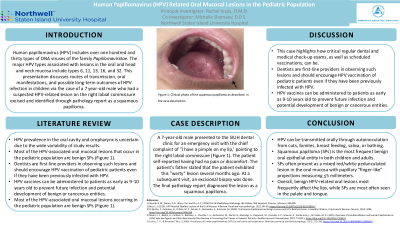Oral Pathology
434 - Human Papillomavirus (HPV) Related Oral Mucosal Lesions in the Pediatric Population


Michelle Shamaev, DDS (she/her/hers)
PGY-2 Pediatric Resident
Northwell Staten Island University Hospital, New York, NY
New York, New York, United States- RI
Rachel Iospa, DMD
Director of Pediatric Dentistry Residency Program
Staten Island University Hospital
Staten Island, New York, United States
Presenting Author(s)
Program Director(s)
Introduction: Human papillomavirus (HPV) includes over one hundred and thirty types of DNA viruses of the family Papillomaviridae. The major HPV types associated with lesions in the oral and head and neck mucosa include types 6, 11, 13, 16, and 32. This presentation discusses routes of transmission, oral manifestations, and possible long-term outcomes of HPV infection in children via the case of a 7 year-old male who had a suspected HPV-related lesion on the right labial commissure excised and identified through pathology report as a squamous papilloma.
Case Report: A 7-year-old male presented to the pediatric dental clinic for an emergency dental visit with a chief complaint of “I have had a pimple on my lip for a long time” as per patient’s father, pointing to the patient’s right labial commissure. The patient self-reported having no pain, discomfort, or issues eating. The patient’s father stated that the patient exhibited this “warty” lesion several months ago; at first, it was almost not noticeable but then grew to its current state, measuring 2 x 2 mm. After his initial visit, the patient was seen at a subsequent visit for excisional biopsy with local anesthesia of the lesion, which was removed in its entirety and submitted for pathology. The final pathology report diagnosed the lesion as a squamous papilloma. The patient returned for follow up several days after the biopsy demonstrating well-healed mucosa in the sampled area.
Identify Supporting Agency and Grant Number:

.jpg)